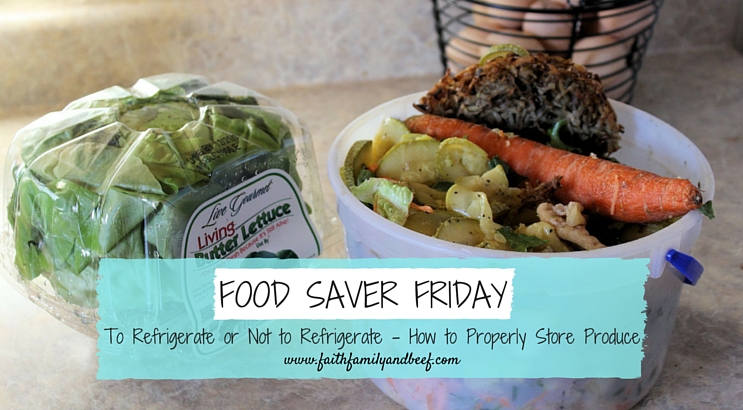A staggering 40% of all food produced is wasted each year in the good ole U.S. of A. A portion of that can be contributed to the persnickety eaters we talked about last time. But I am willing to bet that more of it is the direct result of improper storage. This Food Saver Friday, we are talking food storage – general rules, a few random food storage facts, and how to properly store produce.
To Refrigerate or Not to Refrigerate – How to Properly Store Produce
In most cases food storage is fairly easy. Whether it is a package of beefy goodness or something more processed like cheeses and such, you just follow the instructions on the package label and you are good to go. Where it gets a little hairy (sometimes literally on account of the mold) for me is in the area of fruits and veggies. You know – the perishable produce that comes without handy-dandy informative label with storage instructions.
As a General Rule
- Fruits and veggies should not be stored in the same place. It’s true. They are real-life frenemies and they need their space, on account of the fruit’s flatulence. Okay, not really. But, fruit does give off a gas called ethylene that encourages aging, hastens ripening, and thus, the rotting of innocent bystanders such as veggies. *Hint: This is the single most important step to successful produce storage.
- Veggies need air. Vegetables like to breathe (no wonder they don’t like the flatulent fruits much) and should be stored in such a way that allows for some air circulation. Packing veggies in tight or storing them in an air tight container is just asking for speedy spoilage.
- A pre-storage wash is not required. Really it’s not even encouraged. Washing your fruits and veggies and putting them away damp is like sending an open invitation for a bacteria infestation and a case of the rapid rot. So, it’s really best to not wash your produce prior to storage, but rather just before you eat it.
Little Did I Know
The following are a few fun facts that came as news to me in my research for this post. What about you? Did you know these things? If so, why were you holding out on me?
- So you know how most refrigerators have not one but two crisper drawers? Yep, that is because one should be used for the fruit and the other for the veg. I had no idea. #mindblown
- Potatoes should not be stored next to onions. Nope. Onions in all their layers cause the spuds to sprout, on account of the ethylene gas they give off. Wait. Does that mean onions are a fruit?!?!
- Bananas. Want them to keep longer? Pull them apart and cover their stems with plastic wrap. Why? Well, because doing so reduces the amount of ethylene gas they give off, which in turn slows the ripening process.
- The key to crisp celery that keeps for a month – aluminum foil. That’s right. Celery tightly wrapped in aluminum foil and stored in the refrigerator will not only keep for a month, it will also remain crisp as the day you bought it.
- Cucumbers do not like to be cold. They prefer temperatures above 50 degrees Fahrenheit. So, that means the refrigerator is not really their favorite place to hang. Makes you rethink the phrase, “cool as cucumber,” doesn’t it?
The Infographic
This, my friends, is a cheat sheet I made in the wee hours of the morning. It is Pinable and also an easy-to-read guide on how to store produce.

*Update, or rather, correction: Apples, avocado, kiwi, nectarines, peaches, pears, and plums continue to ripen on the counter, storing them in the refrigerator once they have reached desired ripeness can add a few additional days of freshness.
Additional Resources
These two links are where I got the bulk of the information for this post. And, if you couldn’t tell based on the Little Did I Know section, I needed this info. Turns out – I haven’t been doing myself any favors food waste-wise by putting my cucumbers in the frig, keeping my bananas in a nice neat bunch, and storing my potatoes right next to my onions…
UCDavis Storing Fresh Fruits and Vegetables for Better Taste
The Kitchn’s Guide to Storing Fruits and Vegetables
Next Time on Food Saver Friday
Next time – next time we are talking preservation, which is like storage but different. Preservation is food storage for the long-term, in other words, vacuum packing, freezing, canning, and dehydrating. In the meantime, if you have questions feel free to leave them here in the comments, or shoot us an email using the Contact Me page. And if you’ve missed any of the food saving goodness, click here to catch up.

 Hello! I’m Terryn – the wife, mother, food safety enthusiast, Stormy Kromer fanatic who has slightly (okay, a lot) random tendencies, dabbles in photography, and shares (maybe a little too much) here at FFB.
Hello! I’m Terryn – the wife, mother, food safety enthusiast, Stormy Kromer fanatic who has slightly (okay, a lot) random tendencies, dabbles in photography, and shares (maybe a little too much) here at FFB.